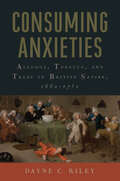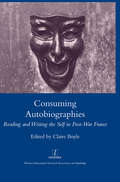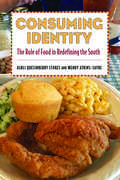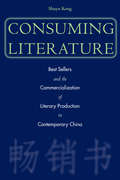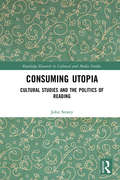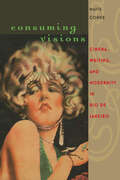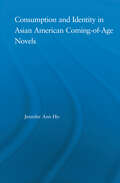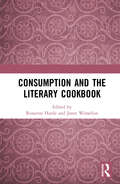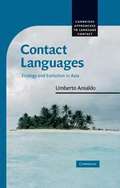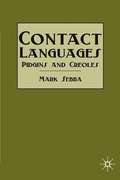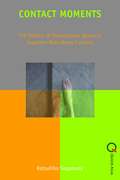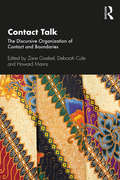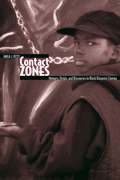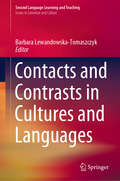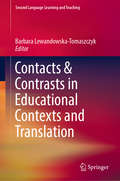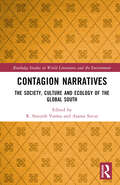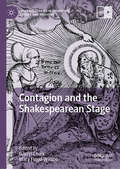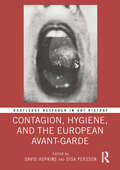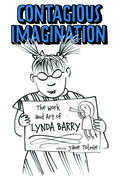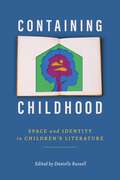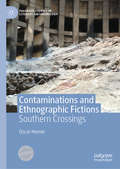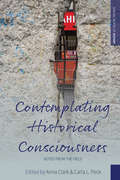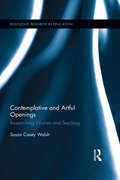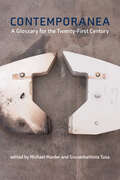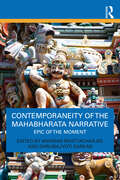- Table View
- List View
Consuming Anxieties: Alcohol, Tobacco, and Trade in British Satire, 1660-1751 (Transits: Literature, Thought & Culture, 1650-1850)
by Dayne C. RileyWriters of the late seventeenth and early eighteenth centuries—a period of vast economic change—recognized that the global trade in alcohol and tobacco promised a brighter financial future for England, even as overindulgence at home posed serious moral pitfalls. This engaging and original study explores how literary satirists represented these consumables—and related anxieties about the changing nature of Britishness—in their work. Riley traces the satirical treatment of wine, beer, ale, gin, pipe tobacco, and snuff from the beginning of Charles II’s reign, through the boom in tobacco’s popularity, to the end of the Gin Craze in libertine poems and plays, anonymous verse, ballad operas, and the satire of canonical writers such as Gay, Pope, and Swift. Focusing on social concerns about class, race, and gender, Consuming Anxieties examines how satirists championed Britain’s economic strength on the world stage while critiquing the effects of consumable luxuries on the British body and consciousness.
Consuming Autobiographies: Reading and Writing the Self in Post-war France
by Claire Boyle"Since 1975, French literary writing has been marked by an autobiographical turn which has seen authors increasingly often tap into the vein of what the French term ecriture de soi. This coincides, paradoxically, with the 'death of autobiography', as these authors self-consciously distance themselves and their writings from conventional autobiography, founding a 'nouvelle autobiographie' where the very possibility of autobiographical expression is questioned. In the first book-length study in English to address this phenomenon, Claire Boyle sheds a new light on this hostility toward autobiography through a series of ground-breaking studies of estrangement in autobiographical works by major post-war authors Nathalie Sarraute, Georges Perec, Jean Genet and Helene Cixous. She identifies autobiography as a site of conflict between writer and reader, as authors struggle to assert the unknowableness of their identity in the face of a readership resolutely desiring privileged knowledge. Autobiography emerges as a deeply troubling genre for authors, with the reader as an antagonistic consumer of the autobiographical self."
Consuming Identity: The Role of Food in Redefining the South (Race, Rhetoric, and Media Series)
by Ashli Quesinberry Stokes Wendy Atkins-SayreSoutherners love to talk food, quickly revealing likes and dislikes, regional preferences, and their own delicious stories. Because the topic often crosses lines of race, class, gender, and region, food supplies a common fuel to launch discussion. Consuming Identity sifts through the self-definitions, allegiances, and bonds made possible and strengthened through the theme of southern foodways. The book focuses on the role food plays in building identities, accounting for the messages food sends about who we are, how we see ourselves, and how we see others. While many volumes examine southern food, this one is the first to focus on food’s rhetorical qualities and the effect that it can have on culture.The volume examines southern food stories that speak to the identity of the region, explain how food helps to build identities, and explore how it enables cultural exchange. Food acts rhetorically, with what we choose to eat and serve sending distinct messages. It also serves a vital identity-building function, factoring heavily into our memories, narratives, and understanding of who we are. Finally, because food and the tales surrounding it are so important to southerners, the rhetoric of food offers a significant and meaningful way to open up dialogue in the region. By sharing and celebrating both foodways and the food itself, southerners are able to revel in shared histories and traditions. In this way individuals find a common language despite the divisions of race and class that continue to plague the South. The rich subject of southern fare serves up a significant starting point for understanding the powerful rhetorical potential of all food.
Consuming Literature: Best Sellers and the Commercialization of Literary Production in Contemporary China
by Shuyu KongThis book examines the changes taking place in literary writing and publishing in contemporary China under the influence of the emerging market economy. It focuses on the revival of literary best sellers in the Chinese book market and the establishment of a best-seller production machine. The author examines how writers have become cultural entrepreneurs, how state publishing houses are now motivated by commercial incentives, and how "second-channel," unofficial publishers and distributors both compete and cooperate with official publishing houses in a dual-track, socialist-capitalist economic system. Taken together, these changes demonstrate how economic development and culture interact in a postsocialist society, in contrast to the way they work in the mature capitalist economies of the West. That economic reforms have affected many aspects of Chinese society is well known, but this is the first comprehensive analysis of market influences in the literary field. This book thus offers a fresh perspective on the inner workings of contemporary Chinese society.
Consuming Utopia: Cultural Studies and the Politics of Reading (Routledge Research in Cultural and Media Studies)
by John StoreyConsuming Utopia builds on critical insights into consumption and utopianism developed in two previous books by the author to elaborate what it means to read utopian fiction (including dystopian and anti-utopian) from the critical perspective of cultural studies. With a critical focus on social practices of reading rather than on the text itself, John Storey advances a timely and relevant contribution to existing debates on utopian fiction, offering new insights into how we might understand the politics of utopian fiction. Finding readership and readers indispensable to the act of producing politics beyond the text, Storey argues that if utopian fiction has a ‘politics’, it is determined by those who, in actuality, pick up books and act on what they read, rather than readers proposed by textuality. By engaging with seminal concepts in cultural studies, this book shows how reading utopian fiction works to make the meaning of such texts material and social, and therefore available for politics. An essential addition to the literature on utopian fiction, this book will be of great interest to scholars and students in the areas of cultural studies, literary studies, comparative literature, cultural politics, utopian studies, and political theory.
Consuming Visions: Cinema, Writing, and Modernity in Rio de Janeiro (New World Studies)
by Maite CondeConsuming Visions explores the relationship between cinema and writing in early twentieth-century Brazil, focusing on how the new and foreign medium of film was consumed by a literary society in the throes of modernization. Maite Conde places this relationship in the specific context of turn-of-the-century Rio de Janeiro, which underwent a radical transformation to a modern global city, becoming a concrete symbol of the country's broader processes of change and modernization. Analyzing an array of literary texts, from journalistic essays and popular women's novels to anarchist treatises and vaudeville plays, the author shows how the writers' encounters with the cinema were consistent with the significant changes taking place in the city.The arrival and initial development of the cinema in Brazil were part of the new urban landscape in which early Brazilian movies not only articulated the processes of the city's modernization but also enabled new urban spectators—women, immigrants, a new working class, and a recently liberated slave population—to see, believe in, and participate in its future. In the process, these early movies challenged the power of the written word and of Brazilian writers, threatening the hegemonic function of writing that had traditionally forged the contours of the nation's cultural life. An emerging market of consumers of the new cultural phenomena—popular theater, the department store, the factory, illustrated magazines—reflected changes that not only modernized literary production but also altered the very life and everyday urban experiences of the population. Consuming Visions is an ambitious and engaging examination of the ways in which mass culture can become an agent of intellectual and aesthetic transformation.
Consumption and Identity in Asian American Coming-of-Age Novels (Studies in Asian Americans)
by Jennifer HoThis interdisciplinary study examines the theme of consumption in Asian American literature, connection representations of cooking and eating with ethnic identity formation. Using four discrete modes of identification--historic pride, consumerism, mourning, and fusion--Jennifer Ho examines how Asian American adolescents challenge and revise their cultural legacies and experiment with alternative ethnic affiliations through their relationships to food.
Consumption and the Literary Cookbook
by Roxanne Harde and Janet WesseliusConsumption and the Literary Cookbook offers readers the first book-length study of literary cookbooks. Imagining the genre more broadly to include narratives laden with recipes, cookbooks based on cultural productions including films, plays, and television series, and cookbooks that reflected and/or shaped cultural and historical narratives, the contributors draw on the tools of literary and cultural studies to closely read a diverse corpus of cookbooks. By focusing on themes of consumption—gastronomical and rhetorical—the sixteen chapters utilize the recipes and the narratives surrounding them as lenses to study identity, society, history, and culture. The chapters in this book reflect the current popularity of foodie culture as they offer entertaining analyses of cookbooks, the stories they tell, and the stories told about them.
Contact Languages
by Umberto AnsaldoWhy do groups of speakers in certain times and places come up with new varieties of languages? What are the social settings that determine whether a mixed language, a pidgin or a Creole will develop, and how can we understand the ways in which different languages contribute to the new grammar? Through the study of Malay contact varieties such as Baba Malay, Cocos Malay and Sri Lanka Malay, as well as the Asian Portuguese vernacular of Macau, and China Coast Pidgin, the book explores the social and structural dynamics that underlie the fascinating phenomenon of the creation of new, or restructured, grammars. It emphasizes the importance and interplay of historical documentation, socio-cultural observation and linguistic analysis in the study of contact languages, offering an evolutionary framework for the study of contact language formation - including pidgins and Creoles - in which historical, socio-cultural and typological observations come together.
Contact Languages: Pidgins and Creoles
by Mark SebbaIn the last three decades, the field of pidgin and creole studies has become recognized as central to modern linguistics. Designed for the student without previous knowledge of the field, this book builds chapter by chapter to give a compregensive overview of current thinking and research on pidgins and creoles.
Contact Moments: The Politics of Intercultural Desire in Japanese Male-Queer Cultures
by Katsuhiko SuganumaThis book sheds light on 'contact moments' between Japanese male-queer culture and that of the West in the postwar period, and critiques various contemporary examples of persistent Orientalism and nativism. Focusing on a range of Japanese as well as English male-queer materials including magazines, memoirs and cybertexts, Suganuma shows how the interactions of the two cultures affected the subject formation process of queer selves. The instances examined range from the hentai magazines of the 1950s and their depiction of men who had sex with foreign men (mostly American servicemen); the depiction of race in the magazine Barazoku; John Whittier Treat's memoir of his sabbatical in Japan and his depiction of his own Orientalism; the writings and strategies of OCCUR and Fushimi in the 1990s; and the GJN news site. The author sees the depiction of and reaction to Japanese men who had sex with foreigners in the hentai magazines as part of a larger pattern of representation manifesting gender anxieties among Japanese men (both heterosexual and homosexual) who found themselves feminized by defeat in the war. He draws on Dyer's understanding of whiteness as a flexible default position in his discussion of Barazoku, but argues that in this case Japaneseness is the default position and whiteness is othered. In his final chapter, he argues for an understanding of the activities of GJN also as a space of mediation rather than simply as a wholesale importation of American or 'global gay' culture. Suganuma argues that the binaries of cross-cultural comparison (local/global, Japan/West, acts/identities, and us/them) can be generative and productive as well as repressive and reductive.
Contact Talk: The Discursive Organization of Contact and Boundaries
by Zane Goebel Howard Manns Deborah ColeWritten by a wide range of highly regarded scholars and exciting junior ones, this book critiques and operationalizes contemporary thinking in the rapidly expanding field of linguistic anthropology. It does so using case studies of actual everyday language practices from an extremely understudied yet incredibly important area of the Global South: Indonesia. In doing so, it provides a rich set of studies that model and explain complex linguistic anthropological analysis in engaging and easily understood ways. As a book that is both accessible for undergraduate students and enlightening for graduate students through to senior professors, this book problematizes a wide range of assumptions. The diversity of settings and methodologies used in this book surpass many recent collections that attempt to address issues surrounding contemporary processes of diversification given rapid ongoing social change. In focusing on the trees, so to speak, the collection as a whole also enables readers to see the forest. This approach provides a rare insight into relationships between everyday language practices, social change, and the ever-present and ongoing processes of nation-building.
Contact Zones: Memory, Origin, and Discourses in Black Diasporic Cinema
by Sheila J. PettyCreated at the crossroads of slavery, migration, and exile, and comprising a global population, the black diaspora is a diverse space of varied histories, experiences, and goals. Likewise, black diasporic film tends to focus on the complexities of transnational identity, which oscillates between similarity and difference and resists easy categorization. In Contact Zones author Sheila J. Petty addresses a range of filmmakers, theorists, and issues in black diasporic cinema, highlighting their ongoing influences on contemporary artistic and theoretical discourses. Petty examines both Anglophone and Francophone films and theorists, divided according to this volume's three thematic sections--Slavery, Migration and Exile, and Beyond Borders. The feature films and documentaries considered--which include Sankofa, Daughters of the Dust, The Man by the Shore, and Rude, among others--represent a wide range of cultures and topics. Through close textual analysis that incorporates the work of well-known diasporic thinkers like W. E. B. DuBois, Aimé Césaire, and Frantz Fanon along with contemporary notables such as Molefi Kete Asante, bell hooks, Clenora Hudson-Weems, René Depestre, Paul Gilroy, and Rinaldo Walcott, Petty details the unique ways in which black diasporic films create meaning. By exploring a variety of African American, Caribbean, Black British, and African Canadian perspectives, Contact Zones provides a detailed survey of the diversity and vitality of black diasporic contributions to cinema and theory. This volume will be a welcome addition to the libraries of scholars and students of film studies and Africana studies.
Contacts and Contrasts in Cultures and Languages (Second Language Learning and Teaching)
by Barbara Lewandowska-TomaszczykThis volume provides descriptions and interpretations of social and cognitive phenomena as well as processes that emerge at the interface of languages and cultures in the context of contrastive and contact linguistics and media discourse. Different contexts are explored with rich empirical findings and authentic exemplifying materials. The book includes fifteen papers, divided into three parts. Part 1 addresses conceptual reflection on languages and cultures in contact and contrast, while Part 2 focuses on contact linguistics and borrowing. Part 3 discusses cultural and linguistic aspects of media discourses.
Contacts and Contrasts in Educational Contexts and Translation (Second Language Learning and Teaching)
by Barbara Lewandowska-TomaszczykThis volume covers descriptions and interpretations of social and cognitive phenomena and processes which emerge at the interface of languages and cultures in educational and translation contexts. It contains eleven papers, divided into two parts, which focus respectively on the issues of language and culture acquisition and a variety of translation practices (general language, literature, music translation) from socio-cultural and cognitive perspectives.
Contagion Narratives: The Society, Culture and Ecology of the Global South (Routledge Studies in World Literatures and the Environment)
by R. Sreejith Varma Ajanta SircarThis volume is a collection of ten essays that direct their gaze to the unfolding of contagions in the non-classical contexts of Asia and Africa. Or, to borrow from the title of one of Partha Chatterjee’s books, they are reflections on the pandemic in most of the world. Featuring many scholars (of the humanities and social sciences) in the Global South, these chapters take as their intellectual focus the political-social as well as the ethical challenges posed by the contagions in the "East." Through analyses of literary narratives/films/video games, this Contagion Narratives traces the manufactured narratives of victimization by majority-communities and the lethal divides consequently being drawn between a reconstituted "authentic majority" and the more vulnerable minority ‘other’ in these societies. The essays in this collection are animated by imaginations of liveable alternatives on a planet on the brink. This volume traces lineages to Buchi Emecheta and Rabindranath Tagore rather than Albert Camus, to Satyajit Ray and the indie traditions rather than Hollywood, and to Buddhism rather than Christianity, to track the historic journeys of "modernity." Using an eclectic set of analytical tools and strategies of textual criticism, this volume argues that ideas of "democracy," even while they carry echoes of other societies, are markedly different as they travel from Gaddafi’s Libya to Wuhan under lockdown to colonial Bengal.
Contagion and the Shakespearean Stage (Palgrave Studies in Literature, Science and Medicine)
by Mary Floyd-Wilson Darryl ChalkThis collection of essays considers what constituted contagion in the minds of early moderns in the absence of modern germ theory. In a wide range of essays focused on early modern drama and the culture of theater, contributors explore how ideas of contagion not only inform representations of the senses (such as smell and touch) and emotions (such as disgust, pity, and shame) but also shape how people understood belief, narrative, and political agency. Epidemic thinking was not limited to medical inquiry or the narrow study of a particular disease. Shakespeare, Thomas Middleton, Ben Jonson, Thomas Dekker and other early modern writers understood that someone might be infected or transformed by the presence of others, through various kinds of exchange, or if exposed to certain ideas, practices, or environmental conditions. The discourse and concept of contagion provides a lens for understanding early modern theatrical performance, dramatic plots, and theater-going itself.
Contagion, Hygiene, and the European Avant-Garde (Routledge Research in Art History)
by David Hopkins Disa PerssonThis interdisciplinary collection of essays brings together scholars in the fields of art history, theatre, visual culture, and literature to explore intersections between the European avant-garde (c. 1880–1945) and themes of health and hygiene, such as illness, contagion, cleanliness, and contamination. Examining the artistic oeuvres of some of the canonical names of modern art – including Edgar Degas, Edvard Munch, Pablo Picasso, George Orwell, Marcel Duchamp, and Antonin Artaud – this book investigates instances where the heightened political, social, and cultural currencies embedded within issues of hygiene and contagion have been mobilised, and subversively exploited, to fuel the critical strategy at play. This edited volume promotes an interdisciplinary and socio-historically contextualised understanding of the criticality of the avant-garde gesture and cultivates scholarship that moves beyond the limits of traditional academic subjects to produce innovative and thought-provoking connections and interrelations across various fields. The book will be of interest to scholars working in art history, literature, theatre, cultural studies, modern history, medical humanities, and visual culture.
Contagious Imagination: The Work and Art of Lynda Barry (Critical Approaches to Comics Artists Series)
by Glenn WillmottContributions by Frederick Luis Aldama, Melissa Burgess, Susan Kirtley, Rachel Luria, Ursula Murray Husted, Mark O’Connor, Allan Pero, Davida Pines, Tara Prescott-Johnson, Jane Tolmie, Rachel Trousdale, Elaine Claire Villacorta, and Glenn WillmottLynda Barry (b. 1956) is best known for her distinctive style and unique voice, first popularized in her underground weekly comic Ernie Pook’s Comeek. Since then, she has published prolifically, including numerous comics, illustrated novels, and nonfiction books exploring the creative process. Barry’s work is genre- and form-bending, often using collage to create what she calls “word with drawing” vignettes. Her art, imaginative and self-reflective, allows her to discuss gender, race, relationships, memory, and her personal, everyday lived experience. It is through this experience that Barry examines the creative process and offers to readers ways to record and examine their own lives. The essays in Contagious Imagination: The Work and Art of Lynda Barry, edited by Jane Tolmie, study the pedagogy of Barry’s work and its application academically and practically. Examining Barry’s career and work from the point of view of research-creation, Contagious Imagination applies Barry’s unique mixture of teaching, art, learning, and creativity to the very form of the volume, exploring Barry’s imaginative praxis and offering readers their own. With a foreword by Frederick Luis Aldama and an afterword by Glenn Willmott, this volume explores the impact of Barry’s work in and out of the classroom. Divided into four sections—Teaching and Learning, which focuses on critical pedagogy; Comics and Autobiography, which targets various practices of rememorying; Cruddy, a self-explanatory category that offers two extraordinary critical interventions into Barry criticism around a challenging text; and Research-Creation, which offers two creative, synthetic artistic pieces that embody and enact Barry’s own mixed academic and creative investments—this book offers numerous inroads into Barry’s idiosyncratic imagination and what it can teach us about ourselves.
Containing Childhood: Space and Identity in Children’s Literature (Children's Literature Association Series)
by Danielle RussellContributions by Miranda A. Green-Barteet, Kathleen Kellett, Andrew McInnes, Joyce McPherson, Rebecca Mills, Cristina Rivera, Wendy Rountree, Danielle Russell, Anah-Jayne Samuelson, Sonya Sawyer Fritz, Andrew Trevarrow, and Richardine Woodall Home. School. Nature. The spaces children occupy, both physically and imaginatively, are never neutral. Instead, they carry social, cultural, and political histories that impose—or attempt to impose—behavioral expectations. Moreover, the spaces identified with childhood reflect and reveal adult expectations of where children “belong.” The essays in Containing Childhood: Space and Identity in Children’s Literature explore the multifaceted and dynamic nature of space, as well as the relationship between space and identity in children’s literature. Contributors to the volume address such questions as: What is the nature of that relationship? What happens to the spaces associated with childhood over time? How do children conceptualize and lay claim to their own spaces? The book features essays on popular and lesser-known children’s fiction from North America and Great Britain, including works like The Hate U Give, His Dark Materials, The Giver quartet, and Shadowshaper. Adopting a multidisciplinary approach in their analysis, contributors draw upon varied scholarly areas such as philosophy, race, class, and gender studies, among others. Without reducing the issues to any singular theory or perspective, each piece provides insight into specific treatments of space in specific periods of time, thereby affording scholars a greater appreciation of the diverse spatial patterns in children’s literature.
Contaminations and Ethnographic Fictions: Southern Crossings (Palgrave Studies in Literary Anthropology)
by Oscar HemerIn an unusual merging of academic and literary practices, this volume attempts to identify a form (or forms) that is congenial with the subject of interrogation: the world in transition, with South Africa as the main focal point. Approaching anthropology from the position of the literary writer, Oscar Hemer here takes the reader through a kaleidoscope of perspectives—a stream-of-consciousness understanding of “writing the city” of Johannesburg, embedding ethnography in subjectivity; a challenge to binaries both temporal and gendered in examining the growth of the IT metropolis Bangalore to a combusting mega-city; an auto-ethnographic interweaving of fictional reportage with a close-reading of anthropological and philosophical treatises, including Mary Douglas’s Purity and Danger and Edouard Glissant’s Poetics of Relation, among others—to interrogate themes of transition, identity, purity and variation in the Western Cape. As the form transcends boundaries to create a methodological hybrid, creolization comes to the fore as a theoretical concept and as cultural practice.
Contemplating Historical Consciousness: Notes from the Field (Making Sense of History #36)
by Anna Clark Carla L. PeckThe last several decades have witnessed an explosion of new empirical research into representations of the past and the conditions of their production, prompting claims that we have entered a new era in which the past has become more “present” than ever before. Contemplating Historical Consciousness brings together leading historians, ethnographers, and other scholars who give illuminating reflections on the aims, methods, and conceptualization of their own research as well as the successes and failures they have encountered. This rich collective account provides valuable perspectives for current scholars while charting new avenues for future research.
Contemplative and Artful Openings: Researching Women and Teaching (Routledge Research in Education #193)
by Susan Casey WalshHighlighting an arts-based inquiry process that involves contemplation, mindful awareness, and artful writing, this book explores women’s difficult experiences in teaching. It weaves a strong autobiographical thread with artifacts from several research projects with female teachers. By linking innovative approaches to research that involve visual images and poetic writing with feminist poststructuralist theories and Buddhist-inspired practices, Walsh offers new understandings about what it means to be critical in research and teaching—and also what transformation, both social and personal, might entail.
Contemporanea: A Glossary for the Twenty-First Century
by Michael Marder Giovanbattista TusaA groundbreaking, multidisciplinary collection that rethinks our present moment and anticipates the key concepts that will shape and direct the twenty-first century.Contemporanea is a nascent lexicon for the twenty-first century edited by seasoned philosophers and authors Michael Marder and Giovanbattista Tusa. The collection showcases perspectives from a range of noteworthy thinkers in philosophy, ecology, and cultural studies, as well as artists, from across the globe, including Slavoj Zizek, Timothy Morton, Denise Ferreira Da Silva, and Vandana Shiva, who each describe what they anticipate will be the concepts shaping the trajectory of this century—everything from the world state to the nuclear taboo, automation to Teslaism, plant sexuality to arachnomancy, and ecotrauma to resonances, to name a few.This century, as the editors explain, has to date grounded itself in the debris of the preceding century, whose revolutions and struggles failed to transform our time: post-colonialism, post-fascism, and post-liberalism have morphed into neocolonialism, neoliberalism, and neofascism, often combined in a previously unimaginable mix. And, just as the political developments at the beginning of the twenty-first century revived and reshuffled those of the preceding epoch, so too have philosophical trends sought to breathe fresh life into the stillborn -isms of the past—realism, vitalism, logicism, materialism, empiricism, criticism—adding the adjective &“new&” and sometimes &“radical&” before them. To articulate a different future, another language is needed. And, to develop another language, one needs to develop fresh concepts, including the concepts proposed in this collection.ContributorsMieke Bal, Claudia Baracchi, Amanda Boetzkes, Erik Bordeleau, Anita Chari, Emanuele Coccia, Valentina Desideri, Roberto Esposito, Filipe Ferreira, Denise Ferreira da Silva, Claire Fontaine, Graham Harman, Yogi Hale Hendlin, Ranjit Hoskote, Cymene Howe, Daniel Innerarity, Joela Jacobs, Ken Kawashima, Sabu Kohso, Bogna Konior, Brandon LaBelle, Anna Longo, Artemy Magun, Michael Marder, Michael Marder, Jason Bahbak Mohaghegh, Timothy Morton, Mycelium, Jean-Luc Nancy, Bahar Noorizadeh, Kelly Oliver, Uriel Orlow, Richard Polt, Marcia Sá Cavalcante Schuback, Tomás Saraceno, Vandana Shiva, Anton Tarasyuk, Anaïs Tondeur, Giovanbattista Tusa, Sjoerd van Tuinen, Santiago Zabala, Zahi Zalloua, Slavoj Žižek
Contemporaneity of the Mahabharata Narrative: Epic of the Moment
by Anirban Bhattacharjee and Dhrubajyoti SarkarNotwithstanding its renowned comprehensive narrative encapsulation of the Indic culture, the Mahabharata keeps on posing a challenge to its contemporary readers: how do we relate to something over two-millennia old in today’s context without freezing it in time? This volume looks at the problem from diverse periods and standpoints and shows us that this challenge is, in fact, a legacy of the Mahabharata and the responses to this challenge are what makes the text ever-contemporary to different readers of different times and positions.It traces the evolution of the Mahabharata from its inception in the fifth century BCE to twenty-first century, spanning classical Sanskrit tradition, Persian and Bengali adaptations, the Mahabharata as a serialized TV show to more recent graphic narratives. By attempting to analyse this diversity, this volume further delves into how the issues in the Mahabharata resonate across time, from the world of ancient sages to contemporary struggles of women. The essays in this book adopt a dual perspective to appreciate both the Mahabharata’s historical context, its exploration of war, heroes and heroines, gender, psychology, philosophy, and its implications for the future.This book will be of interest to scholars and researchers of Indian literature, ancient literature and philosophy, English literature, cultural studies, visual studies, gender studies, and translation studies.
